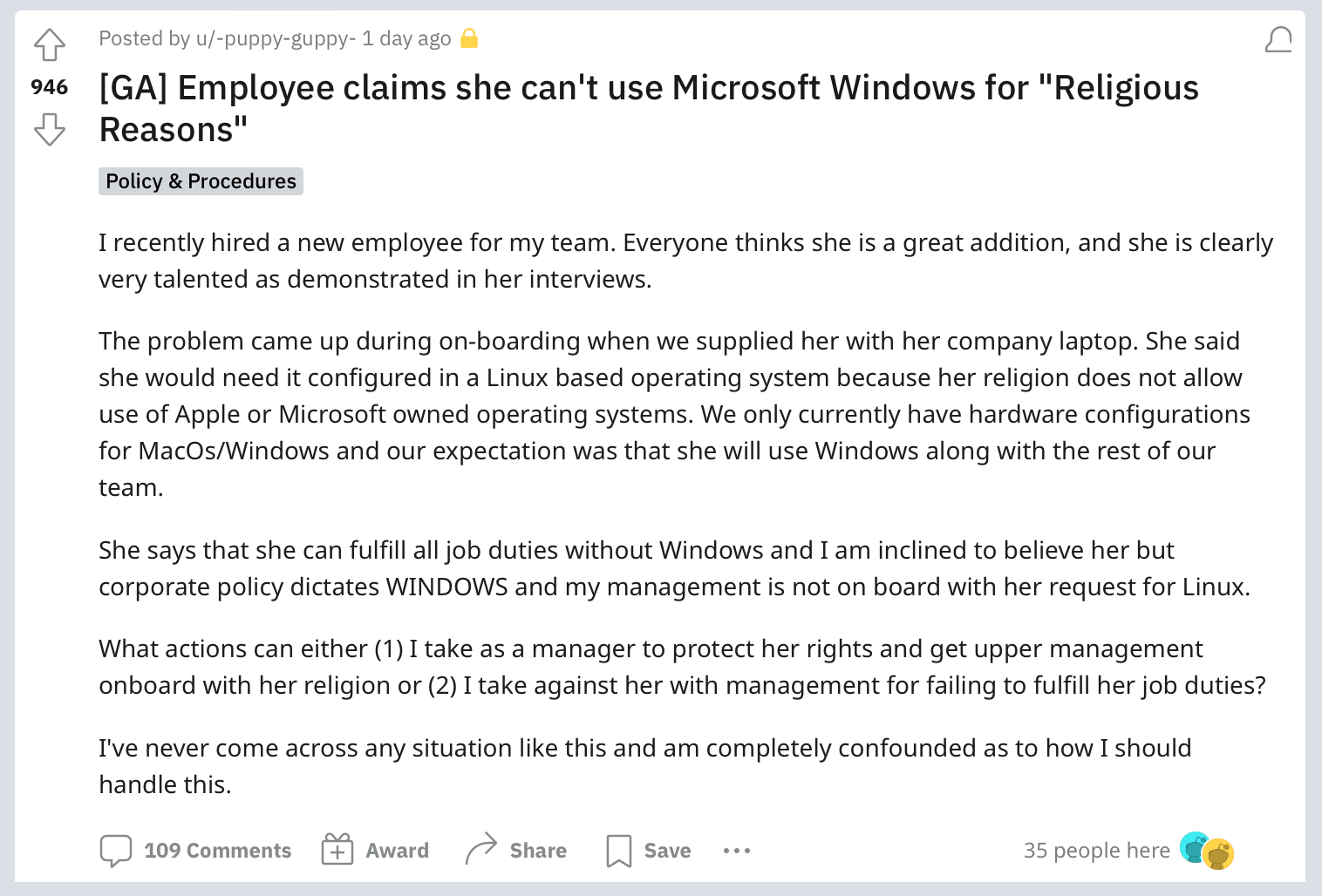And they let her! You mean, all this time, I could have requested Linux on my corporate laptop for religious reasons!? BRB. Going to HR to explain my actual, deeply-held beliefs on this…
Caring about Costs is Cool
But costs aren’t just about the bottomline, they’re also a measure of efficiency. I have a distinct distaste for waste. Money spent on the frivolous or the ill-considered is money that can’t be spent elsewhere. Like an engine drinking too much oil just to run. Tight tolerances (but not too tight!) are a joy in themselves.
Source: Caring about costs is cool
I’ve been a fanboy of DHH for many, many years. Yes, he created Ruby on Rails, which I’m still enamored with, 14 years later, so we have that in common, and as someone who’s made a living using it for the past 10 years, that’s a big deal. However, he’s one of only a couple of people “on the internet” with which I agree with on almost everything, and I’ve never really understood why until this post.
Of course I’ve known that he was an F1 driver, but you can probably drive those cars without understanding the engineering concept of correct tolerances in an engine. That he intuits this premise deeply enough to draw this analogy is the key I was missing to understand my fascination with him.
I may be a programmer (and system administrator, and network engineer, and database architect), but I’m a mechanical engineer at heart. It’s how my mind works. I see how things are related and interconnected. I tell everyone I work with the same thing: I’m awesome at seeing the trees, but pretty bad at seeing the forrest. I’ll give you options; you make the decisions.
Being a physical engineer, whether mechanical or civil or electrical or aeronautical or nuclear, isn’t just a vocation; it’s a way of thinking about the world and how it works. In this way, I think our thinking lines up really well, and I think that leads to thinking basically the same way about most everything else.
It’s a theory, anyway.
Tax Exemption for Churches (Is the Wrong Question)
For the many-th time, I see a repost from Twitter on some other social media site, complaining about the wealth of mega-church pastors, and trying to rile people up about how churches should NOT be tax exempt. And, sure, Joel Olsteen’s lifestyle is a mockery of Jesus’ life, but there are only a handful of “mega” churches and “mega church” pastors in this country. Meanwhile, many, many thousands of the so-called 1% in this country pay a lower tax rate (and sometimes, ACTUAL tax) than the average, blue- or white-collar person does.
As a country swimming in debt, we would get a lot more mileage out of calling for meaningful taxation of billionaires and multi-hundred-millionaires before we start worrying about removing tax exemptions for churches and pastors. I think those posts and reposts on Twitter are probably jointly paid for by The Koch Brothers and George Soros, for the class-warfare angle. And maybe Bill Gates, for the anti-religion angle.
Joel Osteen pays taxes on his income. How much of it he has managed to shelter from the IRS is a game played just like all the rest of the 1%. The church, as a non-profit, does not pay taxes, because the money being received in donations cannot be considered a profit to tax. That’s the definition of how non-profit organizations work.
Churches are supposed to be prevented from getting involved in politics. It’s part of the deal in being religiously tax-exempt. (How this works when Presidents and candidates go to churches and make speeches from the pulpit is quite beyond me, but I digress.) If you start taxing churches, then there’s no reason for them not to get heavily involved in promoting particular candidates, and forming political action committees, just like corporations, taking an active role in getting people elected, and lobbying government for favorable treatment.
You may retort that large, corporate churches like the Catholics or Mormons already exert a huge influence on government, and I’d say you’re right, but it’s still less than the average Fortune 100. If we open the floodgates here… With the “war chests” accumulated by both of those organizations? As they say: you ain’t seen nothing yet.
Do the people calling for the removal of tax exemptions for churches really understand what they’re asking for? I don’t think they do.
Cummins, Brought to You by the Letters B and V
Cummins’ CEO just proudly spammed the whole company, announcing that she was “delighted” that the board has approved 3 more corporate officers for the company.
Goodie.
The only way this announcement affects me is to let me know that the company is now spending several more million dollars per year on executive pay packages. And this is happening as I am watching them like a hawk, and expecting them to announce a 3-5% headcount reduction later this year, to jump on the bandwagon that every other big company is riding.
That’s it. That’s the sum total of the impact of this interruption to my workflow. In fact, I have no idea who inside the company is supposed to benefit from this information, or in what way.
This can only be about juicing news for Wall Street, which has nothing to do with people, and everything to do with holding companies. Cummins is just another one of countless companies in the US which is being run by Blackrock and Vanguard, and various investment banks that you may (or may not) have seen printed on your 401K statements. According to Yahoo!, Cummins is 86% owned by “institutions.” Our country is being run by companies, and our companies are being run by Wall Street.
UPDATE 12/8/23: Many companies are announcing layoffs just before the holidays. (What an annoying time to do so!) Cummins offered early retirement buyouts. I’m hoping that this settles the balance sheet to their satisfaction.
UPDATE 1/4/24: Oops. CEO Jenn Rumsey says this settlement won’t affect stock price, business outlook, or even internal compensation. I hadn’t realized that Cummins made so much money year over year to be able to weather a settlement like this without even a flinch. I think this shows that the figure was reached based on Cummins’ ability to pay, rather than some quantifiable harm their actions supposedly incurred. This feels like a political shakedown, by a liberal administration, of a sympathetic Fortune 250, with deep pockets, which happens to make a product that’s politically unpopular with the party’s base.
Our Lives are Run by Bad Software: Verizon Edition
My son broke his phone, front and back. Instead of fixing it, I went to a local Digital Replay store, and bought a second hand phone. We logged into the phone with his Apple account, which wanted to send a text message to confirm the login. I swapped the SIM card, and it showed up on the new phone, and we were done.
Verizon correctly detected that I replaced his phone, and “helpfully” wanted me to “confirm” it on their service. I get a text on my phone. I log in. It wants to verify me, by sending me another text to the same number that they sent the first one to. If this was supposed to be some sort of security measure, they “dun goofed” already. But this is the experience of all of our lives, at this point, and I play along.
On the web site, I now try to confirm the swap, and it asks me to “confirm” my identity again, with another text message, not 10 seconds after the last time. This time, the web site prompt includes a second code. What’s this code, you ask? I have no freaking clue. I fumble around trying to give it PIN’s and codes that I think it might be looking for, and wind up here:

Remember, Verizon, you asked for this. My son’s phone was working just fine, yet you inserted yourself into my texts, and interrupted my work to hassle me to keep your database correct, and then the process was unnavigable, even for someone with 30 years experience as a “full stack” engineer. Well done. You have to work pretty hard to make this process this frustrating.
Corporate IT “Automated Systems”
Today, I was contacted by #CorporateIT as to whether I was still using <expensive software>. I said no, and that I had tried to uninstall it, but it didn’t work. And, by the way, I’ve tried to “surrender” several other applications, so that my department is no longer billed for them, and NONE of them have worked.
So #CorporateIT guy forwards my email to <IT Director>. I’ve worked at Cummins for 10 years, and still can’t figure out the organizational structure. Anyway, he explains that their systems are great, and process 12,000 requests per month without any problems. I thank him for the considerate response, but this doesn’t change the fact that this has never worked for me, not even once.
Then I get dressed, go into the office, and try to “surrender” one VERY expensive piece of software from a machine that needs to be retired, and I get this error message. Now, I understand that these are (probably) not the same systems under the skin, but it’s the same aggravation, and I just wish that the people running these systems lived in the same IT world that the rest of us do.

Corporate IT “Support”
Suppose you have a problem on your company laptop, for which you contact #CorporateIT, using Microsoft Teams. Now, you’re already logged in as yourself, in Teams, but the first thing they always ask is to confirm that it’s… you, who is contacting them. Then they always ask whether you’re at a company site or home, and what your phone number is. Now, about 90% of everyone is working from home, and with the VPN, it wouldn’t matter anyway. Also, they have no need to call you on the phone. In the rare event they want to use voice, they’ll just use Teams!
So, given the lag of getting a person from the queue, and the normal flow of question and response, you’re about 5-10-15 minutes into the process, and you have wasted the entire time by answering three stupid questions. But if you don’t respond in about 10 seconds, you’ll be badgered with, “Are we still connected?”
After your chat, you’ll get prompted to rate support’s “help” in Teams, and then you’ll get about a dozen emails — whether or not they helped you in any way — including ANOTHER prompt to rate their helpfulness. And they are judged on this. I once rated a support tech poorly, because he was completely unhelpful, and didn’t even try to escalate the problem. He contacted me back to argue about it, and couldn’t disagree with my rating, but pleaded with me to change it, because that’s how they stay employed. I did, but I just don’t bother with the ratings any more.
Our Lives are Run by Bad Software: Discord Edition
A friend invites me to a watch a stream of him playing a game on Discord. I’m not at my computer, so I install the app on my iPad. It asks for credentials, but the login process doesn’t seem to work with 1Password. So I open 1Pass, remember the email I need to type, and copy the password.
I log in on the Discord app, and it puts me through some CAPTCHA thing, and then tells me this is a new device, that needs to be “registered” or something, and sends me an email. I click the link, and a Safari window opens… and goes nowhere. It’s gotten blocked by 1Blocker.
So I copy-paste the URL into Firefox — where I do NOT have an ad blocker, for precisely these scenarios — and it asks me to log in again. Again, 1Password is unhelpful. Again, it sends me through a CAPTCHA…
And I say to myself, you know what? I don’t care any more. I don’t want to see it now. And I close all the browser tabs and I remove Discord from my device, and I complain about it on Twitter.
I go through this ridiculous, digital dance with various services, every single day. EVERY. DAY. I’m sick of it. And I’m just going to stop using every service under the sun, just because they’re free. There’s NOTHING in Discord worth this level of “security” to me.
So, alright, Discord, keep your secrets.
Ebony and Ivory
This is actually what McCartney and Jackson were singing about. Sony and Microsoft, living in harmony.

I bought the Xbox because Microsoft bought Bethesda, and will be making Starfield an exclusive. According to leaks, it’s releasing in the summer. (The Elder Scrolls VI will also be exclusive, but that’s so far off, it’s not fair to talk about.) In the meantime, though, I had been wanting to play through Fallout 4 again. And I did, on my PS5. Except that I started the game with the unofficial patch, because of this, I got stuck and couldn’t finish the Nuka World DLC, which is best part. So not only was I capped at 30 FPS, I got stopped by a bug. On the X, they’ve bumped it up to 60 FPS, so I bought the GOTY edition, did NOT install the unofficial patch, and started playing.
But in looking through the Xbox store, I’ve noticed that you can install Fallout 3 and New Vegas natively on the X. I had been wanting to re-play these two for a long time, but they are basically dead on modern versions of Windows. There are lots of long write-ups for how to get them working, but I’ve tried some, and I can’t seem to do it. They’re “available” on Playstation, but only through their cloud gaming service, and that just doesn’t work well at all. It’s grainy and slow and laggy. So basically, I thought these games were lost forever. I would have thought that they would only be available on Xbox through Microsoft’s version of cloud gaming.
I just installed NV on the X, and it plays GREAT! Fully 60 FPS, and it even looks decent at 4K, which I wouldn’t have thought possible for a 13 year old game. I will probably wind up paying for both 3 and NV and all their DLC. I love Fallout so much, that these games being native on the X, alone, almost make the price worth it to me. And while I’ve waffled between buying an X versus buying a new gaming PC, this clinches it, because this just isn’t (practically) possible any more on PC.
Fallout 76

I screwed up. I’ve been wanting to play Fallout 4 again, but I’m waiting for the next-gen refresh, which is supposedly due “this year.” Fallout 76 is an MMO by Bethesda, which are the same people that do Elder Scrolls Online, which I’ve played a lot of. Even though I’ve loved the Fallout series, I had avoided it when it came out because of terrible reviews, but it was free on the PlayStation Plus collection, so I finally gave it a try.
I was up till 3 am.
Fallout 76 has a difficult time feeling like an MMO. If you run across the map in ESO, you’ll always run into a lot of people. In 76, you can go hours without running into anyone. If you look at the “social” menu on the map, there are usually less than a dozen people listed in the entire instance. That’s just not enough people playing to make it interesting as a multi-player game.
There are in-map “events” which are kind of like ESO dungeons. There are out-of-map “expeditions,” which are kind of like trials. In ESO, you have to queue and wait your turn to run a dungeon, because it’s a very popular thing to do. Half of the events on 76 expire because no one is doing them. The screenshot above shows the most people I’ve ever seen at one time on the server, still, 35 levels later.
If you look on the Steam charts, ESO has like 16K people playing all the time. FO76 has about half that. And that’s for PC. Player counts on consoles are usually about half of those numbers, for both platforms. Combined with this is how they do world/instance provisioning. However, it works out, there are usually only a dozen or so people in any particular instance of 76, compared to hundreds in ESO. (Apparently, the Xbox version has cross play with PC, so that would work better, but that — especially after Bethesda’s acquisition by Microsoft — will never come to Playstation.)
As with ESO (and probably all MMO’s) inventory management is a pain. Like ESO, the monthly subscription includes a bottomless container to hold all your resources, and that alone makes it worth the price.
It’s much simpler than ESO, as there are no classes. Fallout has seven stats, to allocate 56 skill points, and you pick perk card “skills” to go along with the stats you choose to boost. You can easily swap out different allotments of skill points and stacks of perk cards. This part seems really, really nice compared to leveling a main and managing alts for each class in ESO. (Of course, that is a critical part of ESO’s in-game economy, but I digress.)
Unfortunately, I’ve reached level 50, and I seem to have chosen an unwieldy approach. Thinking and feeling like this game was very similar to Fallout 4, I thought I was safe working up an explosive shotgun build. I even managed to “roll” an explosive legendary perk for my combat shotgun on the first try! However, it’s often painful having to close distance to make the shotgun useful. I find that I need more range. Maybe I could make another shotgun for “long” range use, but the whole thing feels really underpowered, even at point-blank range. What I’m noticing, in my admittedly-limited interactions with other people, is that almost no one at higher levels is using shotguns, and it seems that I should be taking the hint.
So now that I’ve leveled up through 50, and chosen all the shotgun-related perks, I find myself needing to spend the next 20 levels or so unlocking perk cards to switch to a different build setup, like commando, for automatic rifle perks. Or maybe rifleman, for single-shot? Or maybe heavy guns? I don’t know.
I see a lot of people in the servers running around at levels ~200-500. I watched a few minutes of a guy on Twitch at level 5025. Yes, I typed that correctly, and you read it correctly. Like, I literally can’t even. Every MMO has “bucket people,” I guess. These people have builds that kill anything in one or two shots, and it’s maddening to me.
To make any build viable for the hardest group content, you have to get really specific about stacking your perks, your legendary effects on armor and weapons, your mutations, your food, and then your chem buffs. Of course, getting the plans and legendaries and recipes and serums is where all the grind is.
I would guess that all MMO’s wind up breaking down like this. Ergo, to do the “best” content takes 1000 hours of grinding to get your build setup to be able to pull your weight doing group activities. I jumped into one event where there were 3 other people who had god-tier builds, and we lost out on the rewards within a minute because we were so overwhelmed. So it’s a bit different than ESO in how you group and do things, but it’s really… the same.
I couldn’t get into ESO’s “single player” experience because the base-game exploration quests were so boring. At least Fallout 76 is kind of Fallout 5, if you don’t get into the “end-game” content. But I think I’ve seen enough. My build is so whack, it’s taking 2-3 clips of ammo to kill random bugs in the world. The ammo situation is a joke, and this is certainly part of the reason why. But, hey, at least there’s no “light weaving” type of real-world-agility-check in the game.
Update
So it turns out that, really, there is a “light weaving” physical dexterity skill involved in the game, if you use a VATS-based build. I’m level 80 now, and I’ve maxed out all the perk cards for VATS-related skills. There’s trick to watching the critical meter fill up, and listening for the sound when it procs, and then hitting a different button to make your next attack a critical. Because the perks can make the meter randomly fill up at any time, there’s no set pattern to the timing. The best way to manage this is to… wait for it… slow down, just like in… ESO.
Sigh.

